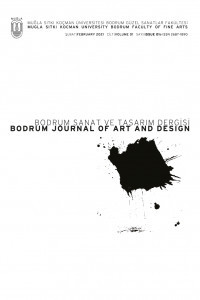Benzersiz ve Alışılmadık: Martin Kardeşler ve Seramikleri
Martin Kardeşler 19. yüzyılda İngiltere’de yaşamış ve özgün, grotesk seramik eserleriyle tanınan bir aile ve aynı zamanda isimleriyle anılan bir işletmedir. Martin Kardeşler’in yaşamları ve seramik atölyelerinin işleyişi, eserlerinin gittikçe özgünleşen üslubu aynı dönemde üretim yapan diğer işletmeler ve sanatçılardan farklı bir noktada anılmalarına neden olmuştur. Yaşadıkları dönemin estetik kaygılarından sıyrılmaları, kendilerine has sosyal davranışları ve sağlık sorunlarının da etkisiyle Martin Kardeşler’in eserleri o dönemde alıcılar ve koleksiyonerler tarafından ilgi çekseler de hak ettiği değeri tam anlamıyla görememiştir. Buna rağmen üslupları ve işlevsel nesneleri işlevini yitirmeden grotesk heykellere dönüştüren benzersiz tasarım anlayışlarıyla Sanat Çömlekçiliği’nin ve dolayısıyla çağdaş seramik sanatının öncülerinden sayılmaktadırlar. Araştırmanın amacı Martin Kardeşlerin seramik üretim serüvenini kendilerine has stilleri ve farklı güncel olaylar ile sanat disiplinlerinden beslenen yaratım süreçleri bağlamında ele almak ve Martin Kardeşler’in çağdaş seramik sanatına katkılarını ortaya koymaktır. Araştırmada betimsel tasarım modeli kullanılmıştır. Martin Kardeşler’in sanatının üç kronolojik evresini kapsayan, amaca yönelik dokuz eser çalışmanın örneklemini oluşturmaktadır. Eserler, içerik analizi yöntemi kullanılarak incelenmiştir. Çalışmanın sonucunda, Martin Kardeşler’in eserlerinin ve işletme modelinin literatürde bahsedilenin ötesinde çağdaş seramik sanatına büyük oranda katkıda bulunduğuna dair bulgulara ulaşılmıştır.
Anahtar Kelimeler:
Sanat, Seramik, Martin Kardeşler, Grotesk
Unique and Unusual: The Martin Brothers and Their Ceramics
The Martin Brothers are a family that lived in England in the 19th century and are known for their original grotesque ceramic works and a business known by their names. The lives of the Martin Brothers, the functioning of their studio, and the increasingly unique style of their artworks have caused them to be remembered at a different point than other studios and artists producing in the same period. Even though the artworks of the Martin Brothers attracted the attention of buyers and collectors at that time, with the effect of getting rid of the aesthetic concerns of the period they lived in, their unique social behaviors, and health problems, they did not get the appreciation they deserved. Despite this, they are considered to be the pioneers of Art Pottery and therefore contemporary ceramic art with their style and unique design concepts that transform functional objects into grotesque sculptures without losing their function. The aim of the research is to discuss the ceramic production adventure of the Martin Brothers in the context of their unique styles, different current events and the creation processes fed by art disciplines, and to reveal the contributions of the Martin Brothers to contemporary ceramic art. The descriptive design model was used in the research. Nine artworks, including the three chronological phases of the Martin Brothers’ art, constitute the sample of the study. The artworks were analyzed using the content analysis method. As a result of the study, it has been found that the Martin Brothers' artworks and business model have contributed to contemporary ceramic art beyond what is mentioned in the literature.
Keywords:
Art, Ceramics, Martin Brothers, Grotesque,
___
- Bilir, T. (2018). Batılı bir sanatçının yorumuyla Şam işi üslubunda İznik çinileri: William De Morgan. Sanat ve Tasarım Dergisi , (22) , 49-69. https://dergipark.org.tr/tr/pub/sanatvetasarim/issue/41779/504048
- Blacker, J. F. (1912). Nineteenth-Century English ceramic art. The Copp, Clark CO. Limited.
- Clark, G. (1995). The potter’s art. Phaidon Press Limited.
- Cooper, E. (2010). 10000 years of pottery. The British Museum Press.
- De Morgan Foundation. (2019). William De Morgan (1839-1917). demorgan.org.uk. https://www.demorgan.org.uk/discover/the-de-morgans/william-de-morgan/ (28.03.2022).
- Hall, S. C. (1872). Minton art-pottery studio, South Kensington. The Art Journal, 11(24), 100-103.
- Head, R. (2009). Martin Brothers: English art potters. antiques-info.co.uk. http://www.antiques-info.co.uk/new/pdf/Sep09/4.pdf (12.02.2022).
- Irvine, L. (2020, July 1). Women’s role in Victorian pottery – chinamania. artsandcraftstours.com. https://artsandcraftstours.com/womens-role-in-victorian-pottery-chinamania/ (08.12.2021).
- Jackson, H. (1977). All manner of folk interpretations and studies. Haskell House Publishers Ltd.
- Livingstone, A., Petri, K. (2017). The ceramics reader. Bloomsbury.
- Neuman, L. (2010). Toplumsal araştırma yöntemleri nitel ve nicel yakaşımlar. Yayın Odası.
- Phillips. (2018). Catalogue essay: Design evening New York auction 13. phillips.com. https://www.phillips.com/detail/r-w-martin-brothers/NY050318/28 (14.04.2022).
- Reif, R. (1981). The haunting world of the Martin Brothers. The New York Times, November 1, Section 2, 32. nytimes.com. https://www.nytimes.com/1981/11/01/arts/antiques-the-haunted-world-of-the-martin-brothers.html (17.05.2022).
- Rose, P. (1979). The grotesque ceramic sculpture of Robert Wallace Martin (1843-1923). The Journal of the Decorative Arts Society 1890-1940, (3), 40-54. http://www.jstor.org/stable/41806218
- Sullivan, E. (2014). French art pottery. metmuseum.org. https://www.metmuseum.org/toah/hd/fapot/hd_fapot.htm (02.02.2022).
- Yayın Aralığı: Yılda 2 Sayı
- Başlangıç: 2022
- Yayıncı: Mugla Sitki Kocman University
Sayıdaki Diğer Makaleler
Emre Arolat Tasarımlarının Mimari Mekân Okumaları
Hastane Tasarımlarının Geçmişten Günümüze Değişiminin Hasta Odaları Üzerinden İncelenmesi
Kurumsal Kimlik Kılavuzu Nedir? Koç Holding Kurumsal Kimlik Kılavuzunun İncelenmesi
Sanat Bağlamında Gündelik Hayatın Eleştirisi ve Sokak Sanatı
Esma Burcu HAVASI, Kaan CANDURAN
Changing Paradigm of Urban Legibility: The Case of Atakule Shopping Mall
Benzersiz ve Alışılmadık: Martin Kardeşler ve Seramikleri
“Garbage In, Garbage Out” Disposal of Waste: A Concept for Reviving Plastic Waste into Art Objects
John Frank ESHUN, Evans Kwadwo DONKOR
